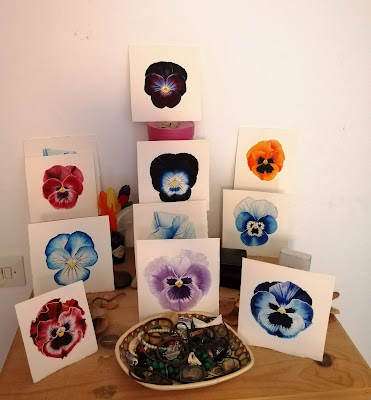As the world dips into chaos for the second time this year, I am hiding in my secret house painting. Project blue once again has been swept into the unknown, just as it was when I was travelling to Egypt on the brink of WWIII. The weeks running up to Egypt had me watching the news like I'd never watched it before. This time I am not watching missiles. I am watching countries shut themselves off one by one. Turning off and going dark, like lights going out in the Blitz.
 |
| Blue Pansy, 1m x 1m, Watercolour on paper. |
One of the many reasons I started the project Blue was in retaliation to Brexit, I plunged myself into the Romantic Movement and behaved as if borders didn't exist. But now there is a new problem on the horizon - a clever virus - and suddenly everything has become much more difficult. With nothing to control the situation but closing borders and shutting oneself away like you would clean laundry in a chest of drawers, I have crept back into my 12th house hole to paint in a house that feels almost as remote as Tasmania. It clutches onto the edge of a national park with no roads and comes with an ancient population of Spaniards. Here I am hidden, here I will weather the storm and work quietly without a car.
"Sometimes I can hear my bones straining under the weight of all the lives I'm not living." —Jonathan Safran Foer, Extremely Loud and Incredibly Close |
| A posy of pansies |
Whilst painting the tight work of the Puya I am simultaneously applying broad washes of bright colours on enormous Pandemic Pansies. I have no idea how they will turn out, the eventual idea was to create an entire wall of them. Something a bit Alice and Wonderland. I like the way the patterns radiate out like hands, like viruses and the way the paint eeks out with 'washes'. They are petals of nostalgia, happy flowers. Gateways, representative of the portals of our hidden transformations. They are botanical butterflies.
 |
| Blue Pansy, Watercolour on paper, £100 |
The name "pansy" is derived from the French word pensée, "thought", and was imported into Late Middle English as a name of Viola in the mid-15th Century. Their other common name "love in idleness" stems from the image of a lover who had little or no other employment than to think of his beloved. In Italy, the pansy is known as 'flammola' (little flame), and I rather like that. A little flame of hope. Hope in the dark.
On account of its popularity in both society and its recurring appearances in Romantic poetry, a variety of new nicknames for the flower began to circulate. Dorothea Lynde Dix proclaims that:
“Perhaps no flower claims to be so universal a favorite, as the viola tricolor; none currently has been honored with so rich a variety of names, at once expressive of grace, delicacy and tenderness.”
Many of these names play on the whimsical nature of love, including “Three Faces under a Hood,” “Flame Flower,” “Jump Up and Kiss Me,” “Flower of Jove,” and “Pink of my John.” In Hamlet, Ophelia distributes flowers with the remark, "There are pansies, that's for thoughts." Interestingly, Margaret Mitchell originally chose Pansy as the name for her 'Gone with the Wind' heroine, but settled on Scarlett just before the book went into print.
With time the Pansy has also become a symbol of two faithful lovers who are separated by distance. This also seems apt under the current circumstances. I know many couples who are trapped in different countries as they ride out the pandemic unable to see or hold one another.
 |
| Giant Pandemic Pansy, watercolour on St. Cuthberts Mill paper. 1m x 1m. |
I sat on my bed last night looking at three giant pansies, which I have placed purposely at the foot of my bed to remind me each time I wake up that the pandemic isn't a bad dream. Now I think the kitchen is the only room in the house not to be taken up by paintings. As I stare at the three faces I feel incredibly strong and happy and surprised at myself. 'Where did these come from?' I ask myself, just as I had done when I painted a quadtych in Tasmania this time last year. Again it feels like a massive evolutionary jump in my art that wasn't forced or predicted. It just happened. I just found myself playing with water and loosening up after the constriction of the Puya. When everyone's in fear, it seems I am still able to play. I hope these broader brush strokes continue.
I hope to continue this series of giant pansies as the pandemic tells its story. These first three giant pansies are destined for Abbott and Holder this August and will be included in the Blue Flower book which I still hope to publish in 2024.
If you are interested in commissioning your very own original small pansy (pictured 15 x 15cm) message me at mail@inkyleaves.com. They are £100 each.
I am remaining in isolation even though everything is opening up. I am rather enjoying this peaceful metamorphosis. Stay safe and wise. x


